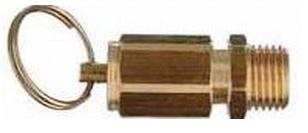Description
Introduction to safety (relief) valves
A safety (relief) valve is fitted purely to prevent the receiver from exceeding the
maximum working pressure and is therefore necessary to protect your life and your property.
1- Because the safety valve may be the only device remaining to protect you from a potentially dangerous situation, it is important that the relief valve is in prime condition.
2- Only qualified people should be allowed to adjust/alter the safety aspect of your air compressor.
3- Safety valves are usually set about 10% above the safe working pressure but this can vary slightly.
4- Do not expose safety valves to freezing temperatures if there is a possibility that the safety valve can come into contact with moisture. Under those circumstances it may freeze solid.
5- A relief valve must be capable of discharging all the air produced by your compressor i.e. if the compressor produces 20 cubic feet per minute (approx. 550 litres per second) at 10 bar then the safety (relief) valve should be capable of exhausting that amount + 10% to atmosphere.
(It is common for the relief valve to be set approx. 10% above the working pressure of the system).
Safety valves are installed in case of the following:
1- Exposure to heat from a fatory/workshop fire (Heat can increase the pressure up to one hundred
times the safe working pressure).
2- Dirt or dust gathering on the cooling apparatus and slowly creating a build-up to mechanical failure over a period of time.
3- Failure of the cut-out pressure switch.
4- Interference of your electrical system by untrained personnel.
5- A slow broadening of pressure \\\\\\\’differential\\\\\\\’ cut-out sequence due to wear on the pressure switch.





 Account
Account
 Cart
Cart
 Click & Collect
Click & Collect
 (+353) 041 983 6923
(+353) 041 983 6923 
